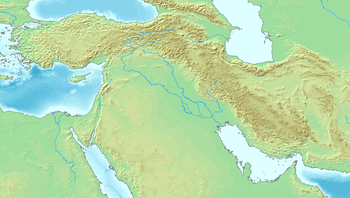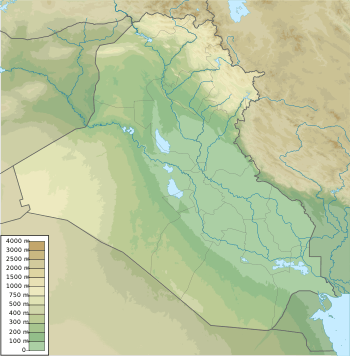Enmebaragesi
Enmebaragesi (cuneiform: 𒂗𒈨𒁈𒄄𒋛 EN.ME.BARAG.GE.SI, fl. c. 2600 BC) was a king of Kish, according to the Sumerian King List. This source adds that he subdued Elam, and reigned 900 years.[3]
| Enmebaragesi 𒂗𒈨𒁈𒄄𒋛 | |
|---|---|
| King of Kish | |
.jpg) | |
| Reign | c. 2600 BC |
| Predecessor | Iltasadum |
| Successor | Aga of Kish |
He is the earliest ruler on the king list whose name is attested directly from archaeology. Two alabaster vase fragments inscribed with his name were found at Nippur where, according to the Sumerian Tummal Inscription, he is said to have built the first temple:[4]
"Enmebaragesi,
The king in this very city (that is Nippur),
built the House of Enlil,
Agga the son of Enmebaragesi,
made the Tummal pre-eminent.
Then the Tummal fell into ruins for the first time.
Meš-Ane-pada built the Bur-šušua in Enlil's temple.
Meš-ki-aĝ-nuna, son of Meš-Ane-pada,
made the Tummal flourish and brought Ninlil into the Tummal."
There are in all at least four surviving fragments bearing the abbreviated form 𒈨𒁈𒋛 Mebarag(e)si, describing him as the lugal of Kish.[7][8] One of them, in the Baghdad Museum, reads 𒈨𒁈𒋛 𒈗 𒆧 "Mebaragsi, King of Kish".[1] As of today, "two fragments of alabaster vessels bear dedication inscriptions of Mebaragesi, king of Kish" are known, which confirms the historicity of this king.[2] The fragments verifying Enmebaragesi's historicity enhance the notion that Gilgamesh is also historical.
Enmebaragesi is also mentioned in a section of the original Sumerian Epic of Gilgamesh, Bilgamesh and Aga, as the father of the Aga who laid siege to Uruk. The Sumerian King List and the Tummal Inscription concur with the Epic of Gilgamesh in making him the father of Aga, who was the final king of the 1st dynasty of Kish. Enmebaragesi is said to have been vanquished by Gilgamesh in a document written by Shulgi, but earlier texts describe his son Aga of Kish as having been vanquished instead.[9]
The later Sumerian Renaissance (Ur III) king Shulgi addressed one of his praise poems to Gilgamesh, that credits Gilgamesh with capturing and defeating Enmebaragesi — thus contradicting the king list, where he was already captured by Gilgamesh's predecessor. In another part of the Gilgamesh epic, Gilgamesh offers his "sister" Enmebaragesi to be the wife of the monster Huwawa or Humbaba, causing some debate as to Enmebaragesi's gender, with most scholars taking this reference as a jest.
Popular culture
In the 2009 comedy film Year One, a film parodying historical, biblical and mythical persons, places and events, Enmebaragesi is portrayed as one of the best hunters from the village.
References
- "CDLI-Archival View". cdli.ucla.edu.
- Katz, Dina (1993). Gilgamesh and Akka. BRILL. p. 12. ISBN 978-90-72371-67-6.
- Thorkild Jacobsen, The Sumerian King List (Chicago: University of Chicago Press, 1939), pp. 82-85
- "The Electronic Text Corpus of Sumerian Literature; ETCSLtranslation : t.2.1.3; The history of the Tummal". Retrieved 2008-04-22.
- Kramer, S.N. (1963). The Sumerians: their history, culture, and character. University of Chicago Press. p. 46. Retrieved 2011-12-29.
- "CDLI-Found Texts". cdli.ucla.edu.
- "CDLI-Found Texts". cdli.ucla.edu.
- catalogue of Enmebaragesi-era texts on CDLI wiki
- Katz, Dina (1993). Gilgamesh and Akka. BRILL. p. 15. ISBN 978-90-72371-67-6.
External links
| Regnal titles | ||
|---|---|---|
| Preceded by Iltasadum |
King of Sumer Lugal of Kish ca. 2600 BC |
Succeeded by Aga |

